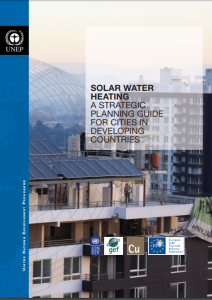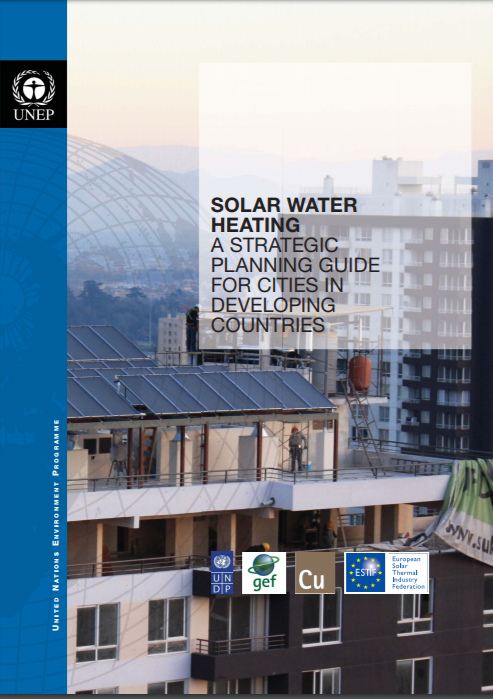 As the world’s population continues to move into cities and urban energy demand increases, local offi cials – especially those in developing countries – are increasingly under pressure to address a range of energy, economic, and climate priorities. Cities, for example, produce approximately three quarters of the world’s greenhouse gas emissions and account for a similar proportion of the world’s energy demand.
As the world’s population continues to move into cities and urban energy demand increases, local offi cials – especially those in developing countries – are increasingly under pressure to address a range of energy, economic, and climate priorities. Cities, for example, produce approximately three quarters of the world’s greenhouse gas emissions and account for a similar proportion of the world’s energy demand.
At the same time, thermal energy consumption across the globe – including energy used for water heating – has been rising steadily since 2000 and is expected to continue to be a major proportion of total global energy demand in the future. Addressing these issues will require creative new energy, economic, and policy solutions.
Solar water heating (SWH) has signifi cant potential to help local offi cials and urban planners address the needs and priorities of their jurisdictions. At the residential and commercial building level, SWH can provide a sustainable, reliable and cost-effective option for endusers.
At the city level, SWH can improve energy access for city residents, improve the stability of energy costs and the reliability of the electrical grid, create opportunities for new jobs, and reduce a city’s greenhouse gas footprint.
Despite these benefi ts though, there are number of persistent market barriers that impede SWH market development in cities (see Section 4.1). This includes high upfront costs, inadequate fi nancing, and lack of skilled labor. In many jurisdictions, there is also a general lack of awareness of SWH market potential and/or the perception that SWH is too complicated.
Facing these challenges, how can city offi cials effectively align stakeholder interests, mitigate market barriers, and create successful policies and programs to drive SWH market development?
A SWH strategic plan is a key planning tool that can help urban leaders in developing countries across the globe jumpstart SWH market development. This document provides a detailed overview of the SWH strategic planning process (see Section 2), describing key steps in the process. This includes initial steps to build political support, like recruiting support from top city leadership, designating a SWH coordinator, and convening advisory committee members. It also describes how SWH coordinators can analyze the city’s installation baseline, identify the most important market development barriers, and leverage SWH development opportunities.
Local officials and planners can then establish SWH market goals and the necessary enabling policies and programs to achieve them. Throughout this document, a range of SWH policies, programs, and case studies are described, which have helped jumpstart SWH market development in jurisdictions ranging from Kaohsiung City in Taiwan, to the Lebenese Republic in the Middle East, to the U.S. state of California. UNEP Solar Water Heating – A strategic planning guide for cities in developing countries
Key SWH policies and programs include:
- Incentive programs that can increase SWH access by reducing high upfront cost and/or increasing SWH competitiveness compared with conventional (often subsidized) fossil fuels. This encompasses a range of different mechanisms, including upfront rebates, performance-based incentives (PBIs), and hybrid incentive structures (see Section 4.2).
- Financing and innovative business models that reduce high upfront costs, mitigate fi nancial risk, and increase customer access to SWH. This includes low-interest lending programs, utility on-bill programs, and innovative contractor business models that provide “heat as a service” (see Section 4.3).
- SWH mandates and regulations that address landlord-tenant barriers and low customer awareness of SWH. A number of jurisdictions have implemented mandates or regulations that require the installation of SWH systems in new and existing buildings, at the time of building sale or lease, or at the time that existing heating systems are replaced. This section also includes an overview of utility mandates, which require utilities to derive a certain portion of their total energy load from renewable resources like SWH (see Section 4.4).
- Permitting, training and quality control programs that can address challenges related to the lack of skilled labor and/or poor quality of SWH installations in local jurisdictions. City leaders can work with industry to address these challenges – and improve the strength of the SWH market – by implementing streamlined SWH permitting processes as well as new training or certification programs (see Section 4.5).
- Outreach and education programs that can address SWH information, awareness and communication gaps. These include consumer advertising and awareness campaigns, group purchasing programs, and demonstration projects – all of which increase customer awareness of and confi dence in SWH (see Section 4.6).
Ultimately, SWH represents an untapped renewable energy resource and market opportunity for many cities in developing countries. This guide provides a helpful starting place for planners, elected offi cials, and other city leaders to build a SWH market in their locale. While there are barriers to SWH, these obstacles can be overcome with a strategic planning process and the implementation of targeted and effective policies and programs.

